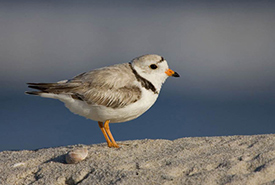The Magdalen Islands

Piping plover (Photo by Natural Resources Canada)
A unique natural environment
The Magdalen Islands are located in the middle of the Gulf of Saint Lawrence, between the Gaspé Peninsula and Cape Breton Island in Nova Scotia. Made up of around 15 islands and islets, seven of which are connected by sandbars, the archipelago is completely different from the rest of Quebec. Dunes and beaches make up around a third of the land area. Despite their small size, the Magdalen Islands are home to 14 at-risk species. They also include 14 zones recognized as Important Bird Areas (IBA).
The Nature Conservancy of Canada (NCC) has been protecting the Magdalen Islands’ fragile habitats for almost 20 years. NCC is currently working in the areas of Havre-Aubert and the Pointe de l’Est.
Havre-Aubert
Havre-Aubert is known for its exceptional wetlands. These provide habitat for a variety of wildlife species, including several at-risk species. Piping plover, a bird designated as endangered in Canada and threatened in Quebec, nests on the beaches of the Baie de Plaisance. Identified as a high priority site for conservation by the Société de conservation des Îles-de-la-Madeleine (SCÎM - Magdalen Islands Conservation Society), the dune area of Havre-aux-Basques has been targeted for protection by NCC.
In 2013, NCC and its partners secured the largest private property in the area. The property, now a conservation agreement with the Quebec government, measures 42 hectares. The Communauté maritime des Îles-de-la-Madeleine engaged in a great collective effort to safeguard this natural environment of high ecological value. In fact, it won the award “Villes et villages à la rescousse!” (Towns and villages to the rescue!) in 2015 for its work to protect the piping plover’s habitat at Havre-aux-Basques.
The Pointe de l’Est
The Pointe de l’Est is a vestige of a unique ecosystem in Quebec. It showcases typical elements of the Magdalen Islands landscape (lagoons, marshes, salt-meadows, extensive beaches and freshwater, brackish, or saltwater ponds, etc.). These natural environments are important for several species of ducks and shorebirds. They provide nesting grounds and shelter for several important species, such as piping plover and horned grebe, two species designated as endangered in Canada and threatened in Quebec. Three provincially threatened plant species can also be found here:
- Gulf of St. Lawrence aster
- broom crowberry
- bog huckleberry
To date, NCC has helped protect around 60 hectares of natural areas of high ecological value in Pointe de l’Est.
NNC intends to continue, in collaboration with its partners, ensuring securement and stewardship of conservation lands in the Magdalen Islands.
Partners
NCC thanks its partners who have contributed to protecting these habitats:
- Government of Quebec
- Government of Canada - North American Bird Conservation Initiative
- Environment and Climate Change Canada - Habitat Stewardship Program for Species at Risk
- US Fish and Wildlife Services
- Fondation de la faune du Québec
- Communauté maritime des Îles-de-la-Madeleine
- Canadian Wildlife Service
- Wildlife Habitat Canada
- Metcalfe Foundation
- Société de conservation des Îles-de-la-Madeleine





